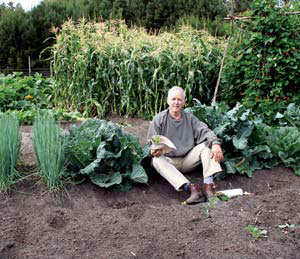
How much land do I need to grow all my own vegetables?
 Steve
Solomon grows vegetables in an area about 2,000 square feet in size
(about 2,700 feet if paths are included) to feed himself and
his wife half of their daily calories. He is currently able to
use copious soil amendments and irrigation, and also benefits from
gardening in an area where the soil doesn't freeze solid in the
winter. Without those advantages, Solomon estimates that he could
need as much as 9,000 square feet to feed his family. If he
wanted to include potatoes and sweet potatoes in his garden to fulfill
more
of his food requirements, he would add another 1,000 to 1,500 square
feet for a total of a tenth to a quarter of an acre to feed two adults.
Steve
Solomon grows vegetables in an area about 2,000 square feet in size
(about 2,700 feet if paths are included) to feed himself and
his wife half of their daily calories. He is currently able to
use copious soil amendments and irrigation, and also benefits from
gardening in an area where the soil doesn't freeze solid in the
winter. Without those advantages, Solomon estimates that he could
need as much as 9,000 square feet to feed his family. If he
wanted to include potatoes and sweet potatoes in his garden to fulfill
more
of his food requirements, he would add another 1,000 to 1,500 square
feet for a total of a tenth to a quarter of an acre to feed two adults.
In addition to this
garden area, Solomon sets aside another area of
equal size and rotates his entire garden every three to five
years. He argues that if you live in an area where the ground
doesn't freeze solid in the winter, disease and insect infestations
will build up to a point where your yields begin to decline after a few
years, even if you rotate crops. So
he manages a ley equal in size to his current garden, where he grows
grass and clover, cutting the greenery a few times a year and letting
the clippings rot into the ground to increase the soil's
fertility. After a few years, he tills up the ley and turns it
into garden, then sows the old garden into a ley.
This is one of the areas
where I wish that Gardening
When It Counts
went into a little greater depth. While I agree that people have
been letting land lie fallow and rotating vegetables through these
areas at intervals for a long time, I wonder whether a permaculture
approach could result in a garden ecosystem that was resilient enough
to prevent disease and pest outbreaks. I'll discuss in a later
post how Solomon uses a mixture of seedmeal, lime, guano, and kelpmeal
as his primary fertilizer and only adds a relatively small amount of
compost. If he added more organic matter to his soil every year,
would this whole garden rotation be unnecessary since the plants
wouldn't get micronutrient
deficiencies and
would be healthy enough to resist diseases and pests? The
necessity of tri-annual tilling using Solomon's method turns me off,
but I can't say for sure whether my method will be any better since
this is only our fourth garden year.
This post is part of our Gardening When It Counts lunchtime series.
Read all of the entries:
|
Want more in-depth information? Browse through our books.
Or explore more posts by date or by subject.
About us: Anna Hess and Mark Hamilton spent over a decade living self-sufficiently in the mountains of Virginia before moving north to start over from scratch in the foothills of Ohio. They've experimented with permaculture, no-till gardening, trailersteading, home-based microbusinesses and much more, writing about their adventures in both blogs and books.
Want to be notified when new comments are posted on this page? Click on the RSS button after you add a comment to subscribe to the comment feed, or simply check the box beside "email replies to me" while writing your comment.

I've had some kind of garden here for 15 years (how much depending on how busy I was with other things). Last year and now again this year, I've doubled the size of the garden. I don't till, and never did, and I use primarily compost, including horse, rabbit and chicken manure, to enrich the soil. I agree with Steve Solomon about letting a portion of your garden rest every few years--that's an ancient and long-proven axiom--but disagree with most everything else he preaches, lol. His COF formula uses several things that are GMO, or heavily laced with pesticides (canola or cottonseed meal), and several things that are almost impossible to find in my rural area (kelp and bone meal).
I fed my family of three adults almost entirely from the garden last year, except for meats and grains (and this year I have wheat planted as well). In the past, when my children were little, I fed our family of six from an intensively managed garden in a suburban back yard.
To be fair, he just says "seedmeal" and doesn't tell you what type - just to use what's available in your area. He also says that coffee grounds count as seedmeal, which makes for a free and easy-to-find ingredient if you live near a town with cafes.
The kelpmeal and bonemeal were optional ingredients in COF, so if you can't get them don't worry about them.